|
How to Take Part - Tutorial
Your job is very simple! All you need to do is look out for the features that mark out spiral and elliptical galaxies. In fact, as you're a human and not a computer, most galaxies should be easy to classify since they're obviously spirals or obviously ellipticals. On this page, you will practice classifying galaxies. On the next page, you will take a short trial to test your skills. If you don’t pass the trial, you can try again. Once you pass the trial, you can start contributing to Galaxy Zoo science!
Part 1A ... Spiral or Elliptical Galaxies?
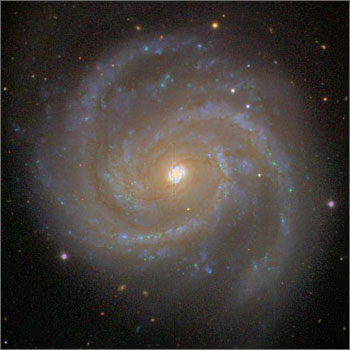
|
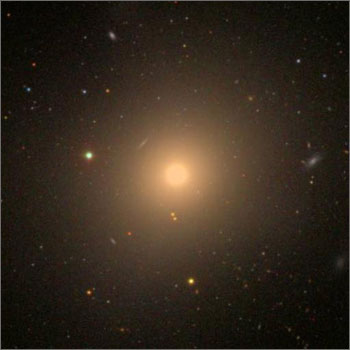
|
This is a face-on
Spiral Galaxy. You can clearly
see the spiral arms and a central bulge.
|
This
Elliptical Galaxy
is composed entirely of a
bulge of stars. There is no disk or spiral arms.
|
Try your hands at some!
Click the image to see if you're right.
Part 1B ... More Tricky Spiral or Elliptical Galaxies
Some galaxies are a bit more tricky. As you noticed in the previous section, some spiral galaxies can look like ellipticals when viewed edge-on. Also, in some faint spiral galaxies, you have to look hard to see the spiral arms. Now, see if you can separate the genuine ellipticals from the spirals.
Try your hands at some!
Click the image to see if you're right.
Part 1C ... Merging Galaxies
Sometimes, galaxies crash into each other, or come close. These are called merging galaxies. Merging galaxies are very interesting to astronomers because we think that large galaxies are built from mergers of small galaxies – if we see merging galaxies, we can see a snapshot of how that process happens. When you look for mergers, look for places where two galaxies appear to be merging into one. The galaxies should be close together, and you should be able to see some connection between them. In the trial or in your galaxy analysis, whenever you see this, click the button that says "Mergers".
Although merging galaxies are interesting, they are also rare. You may classify hundreds of galaxies before you see some merging. But if you see one, be sure to mark it!
Try your hands at some!
Click the image to see if you're right.
Part 1D ... Very Faint Spiral or Elliptical Galaxies
Now for the hardest part. Most galaxies in the GalaxyZoo sample are billions of lightyears away and very faint. These can be quite tricky to tell apart. See if you can tell whether these galaxies are spirals or ellipticals!
Try your hands at some!
Click the image to see if you're right.
When analysing real galaxies, you will be presented with two decorated buttons: click the one corresponding to the correct galaxy type.
Now you are ready to proceed to
Part 2
of the tutorial.
Part 2A ... Clockwise and Anti-clockwise Spiral Galaxies
If you decided that the galaxy is spiral, then you will also be asked to determine whether it spins clockwise or anti-clockwise with respect to an observer in our galaxy.
With face-on spiral galaxies, this is a very easy task. The clockwise and anti-clockwise rotating galaxy look like this:
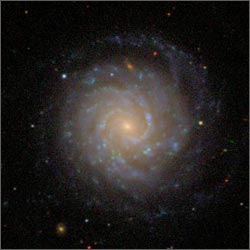
|
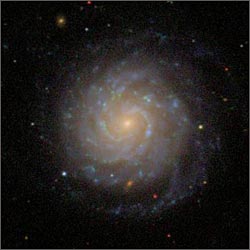
|
| This is a clockwise, face-on spiral galaxy |
This is an anti-clockwise, face-on spiral galaxy |
And, by the way, you are right, we did use just two mirror images of the same galaxies to make the difference clear. Note how the arms of both kinds of spiral galaxies point the opposite way to their motion, as if they are being dragged behind.
With galaxies that are observed at some angle with respect to the angle of rotation, the task might be more difficult. Below are images of two such galaxies, but one can still discern the direction of the rotation:
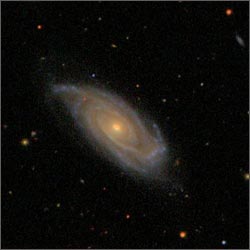
|
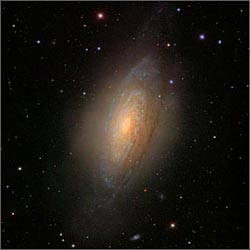
|
|
This is a
clockwise, on-edge
spiral galaxy
|
This is an
anti-clockwise, on-edge
spiral galaxy
|
For truly edge-on galaxies, it is impossible to work out the direction of rotation from a simple image alone. Such galaxies are classified as edge-on.
Part 2B
Now try a few test cases to warm up:
Part 3 ... Star / Don't Know (stars, green streaks, irregular galaxies, and others)
In addition to galaxies, you might see some things that look strange to you, like these:
The image on the left – a bright object with spikes of light coming out of it like a plus sign – is a
star. The spikes of light happen because the star’s light bends around the four support beams that hold up the telescope’s mirror. They aren’t really part of the star.
The image on the right – a brightly-coloured streak of light going all the way across the picture you are trying to classify – is a
satellite trail. As satellites orbit Earth, sunlight reflects off their solar panels, making them look very bright from the ground. Because the satellite is moving as the telescope’s camera is taking an image, the satellite makes a trail – a streak across the image. The trail is coloured because the colour images for the site are made by combining three black-and-white images, and the satellite only appeared in one image.
In the trial or in your galaxy analysis, whenever you see a star or a satellite trail, click the button that says "Star/don’t know".
Now, try some test cases to practice telling the difference between stars, satellite trails, and real galaxies.
Try your hands at some!
Click the image to see if you're right.
Galaxy Analysis Trial
To make your task easier, you will be presented with four buttons: Spiral Galaxy, Elliptical Galaxy, Star/Don’t Know, and Mergers. The spiral galaxy button will be subdivided into Clock (for clockwise spirals), Anti (for anticlockwise spirals), and Edge On (for edge-on spirals). You will need to click on the most appropriate button. If you cannot discern the direction of rotation, for example because the image is fuzzy or spiral arms are difficult to make out, you should press the "edge-on" button,
Now press the button to proceed to a small trial. You will be asked to fully classify 15 galaxies. If you correctly classify 8 or more, you will be able to start working on the real challenge.

|